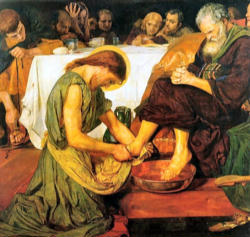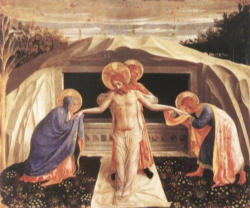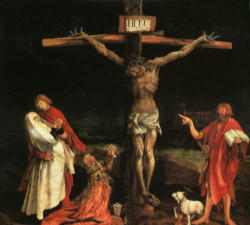Last Sunday we celebrated Passion or Palm Sunday to begin what is called the Great or Holy Week. Just prior to the reading of the Passion Narrative, we heard proclaimed one of the most ancient of the passages contained within the Sacred Scripture. St. Paul´s powerful words concerning Jesus´ great self emptying, in Greek, His “kenosis”, recorded in the second chapter of his letter to the Philippians. “Christ Jesus, though he was in the form of God, did not regard equality with God something to be grasped. Rather, he emptied himself.” (Phil. 2:6-11)
The Vigil Mass of Holy Thursday begins the celebration of what is called the Sacred “Triduum”, a Latin expression for “Three Days.” The Liturgies of these Holy Days have the capacity to effect great conversion in those who participate. Last year, Pope Benedict XVI reminded the faithful they “could be considered one single day. They reveal the heart and are the key to both the liturgical year and the life of the Church.”
These liturgies deepen our understanding of the Mystery of the self emptying of Jesus Christ. We celebrate the gift of the ministerial priesthood which continues to make present the one Priesthood of Jesus Christ. When our Priest stands at that altar, it is Jesus Christ in whom He stands, Christ is the victim, and Christ is the Holy Oblation. Jesus gave Himself to us in the great meal in which we participate in on this Holy Night. The Holy Sacrifice of the Mass is the Holy Oblation of Incarnate Love and we are the beneficiaries, receiving the very life of God; the very Body and Blood of Jesus Christ.
This understanding of the ministerial priesthood is held by both Catholic and Orthodox Christians. It is also one of the most misunderstood teachings of the Church among many of our friends in the protestant and Evangelical communities. It is grounded in an ecclesiology, an understanding of the Church. The Church is not an organization which we fashioned. Rather, it is the Body of Christ, the very plan of God for the whole world, made manifest in Jesus Christ who is its Head. It is why He came. To found a new people and begin the New Creation which will only be complete when He returns and we are raised and there is a new heaven and a new earth. On Holy Thursday, we celebrate the choice He made of the Apostles, the ones through whom he would continue his Redemptive mission until that glorious return. As the first priests, His plan was for them, and all priests – standing in Him – to continue His redemptive work through His Body, the Church which he founded.
The Catholic Catechism explains: “The redemptive sacrifice of Christ is unique, accomplished once for all; yet it is made present in the Eucharistic sacrifice of the Church. The same is true of the one priesthood of Christ; it is made present through the ministerial priesthood without diminishing the uniqueness of Christ’s priesthood: “Only Christ is the true priest, the others being only his ministers.” In other words there are “two participations in the one priesthood of Christ… Christ, high priest and unique mediator, has made of the Church “a kingdom, priests for his God and Father.” The whole community of believers is, as such, priestly. The faithful exercise their baptismal priesthood through their participation, each according to his own vocation, in Christ’s mission as priest, prophet, and king. Through the sacraments of Baptism and Confirmation the faithful are “consecrated to be . . . a holy priesthood.”
“The ministerial or hierarchical priesthood of bishops and priests, and the common priesthood of all the faithful participate, “each in its own proper way, in the one priesthood of Christ.” While being “ordered one to another,” they differ essentially. In what sense? While the common priesthood of the faithful is exercised by the unfolding of baptismal grace – a life of faith, hope, and charity, a life according to the Spirit – , the ministerial priesthood is at the service of the common priesthood. It is directed at the unfolding of the baptismal grace of all Christians. The ministerial priesthood is a means by which Christ unceasingly builds up and leads his Church. For this reason it is transmitted by its own sacrament, the sacrament of Holy Orders.”
Some of our Protestant friends believe that the Catholic Church teaches that the priest somehow “replaces” Christ. That is absolutely incorrect. Rather, the ministerial priest stands, again from the Catechism, “in the person of Christ the Head . . .In the ecclesial service of the ordained minister, it is Christ himself who is present to his Church as Head of his Body, Shepherd of his flock, high priest of the redemptive sacrifice, Teacher of Truth. This is what the Church means by saying that the priest, by virtue of the sacrament of Holy Orders, acts in persona Christi Capitis” (CCC #1546-1549)
The Latin expression means “in the person of Christ the Head”. Along with copious citations from the scriptures and Christian tradition in the Catechism is this short summary from St. Thomas Aquinas “Christ is the source of all priesthood: the priest of the old law was a figure of Christ, and the priest of the new law acts in the person of Christ.”
So, the meal which we celebrate this evening, called the Last Supper, was the first Mass, the First Divine Liturgy. It is also outside of time. At the Last Supper, Jesus, the High Priest, Sacramentally anticipated the altar of the Cross at which He would willingly pour out the very last drop of His Blood so that we could be set free to live free to live our lives in Him, for Him and with Him, in the Church for the sake of the World. St. Paul told the Galatian Christians, “For freedom Christ set us free.” (Gal. 5:1) Then, when the Lord rose from that table, He also showed us the naturally supernatural expression of that Love; an expression that symbolically reveals the Christian vocation.
He, who is Lord and Master, King of Kings, took off His Cloak of Royal Splendor and became a Servant. He washed the feet of those whom He had chosen to continue His Redemptive work. He showed them what they were chosen to do and then He enlisted them to live lives of self emptying Love for the world. To bear the name “Christian” is to walk in this kind of love in the midst of a broken and wounded world that is waiting to be reborn.
This is the world which He still loves. It is being recreated anew as He continues His Mission through His Church, which truly is His Body. The early Christians spoke of the Church as the world in the process of being transfigured. And, my friends, we are a part of that Body, that Communion, which brings heaven to earth and earth to heaven. It is in this sense that we come to understand that Christian love is to be lived, that love is a verb.
Our Priest, standing, to use the Latin “in persona Christi“, will rise, and taking the basin, towel and washcloth, he will wash the feet of twelve people chosen to symbolize the sacrificial service of love offered by the whole parish. The Love of Christ, the Incarnate Word, the Second Person of the Blessed Trinity, is made into symbolic action, because Love is a verb. Love is a command, a mandate. This foot-washing is more than a re-enactment of an actual historic event; it is an invitation to participate in the ongoing redemptive mission of Jesus Christ through His Church.
Foot washing is a symbolic action. It expresses what living this kind of Eucharistic Life, a life of self emptying love in imitation of the Lord who emptied Himself for us, looks like. It has been traditionally referred to as “the Mandatum”, the Command. It is an invitation to become a man or woman poured out for others. A Christian who lives the love of Charity (Caritas), the Love of Jesus Christ, makes Jesus Christ real in the real world. In so doing, the Incarnation continues.
In our participation in the Mysteries of these three Holy days, this one day; we will encounter the Lord Himself, alive in His Body. In that encounter He calls us afresh to follow Him, to bear His name in the real world. To pray and live in that name, Christian, it helps to remember what names meant in the biblical sense. They communicate identity. Through grace we are capacitated to become an “epiphany” a manifestation of the self emptying Servant love of Jesus the Christ.
In His first encyclical (a word which means circulating) letter, entitled “God is Love”, Pope Benedict XVI wrote of the inner dynamic which happens when we participate in the Holy Eucharist: “The Eucharist draws us into Jesus’ act of self-oblation. More than just statically receiving the incarnate Logos, we enter into the very dynamic of his self-giving. Union with Christ is also union with all those to whom he gives himself. I cannot possess Christ just for myself; I can belong to him only in union with all those who have become, or who will become, his own. Communion draws me out of myself towards him, and thus also towards unity with all Christians. We become “one body”, completely joined in a single existence. Love of God and love of neighbor are now truly united: God incarnate draws us all to himself….”
The passage which we will hear proclaimed by the Deacon or Priest at Holy Mass this Holy Thursday evening is taken from the fourth Gospel: “So, during supper, fully aware that the Father had put everything into his power and that he had come from God and was returning to God, he rose from supper and took off his outer garments. He took a towel and tied it around his waist. Then he poured water into a basin and began to wash the disciples’ feet and dry them with the towel around his waist. So when he had washed their feet and put his garments back on and reclined at table me ‘teacher’ and ‘master,’ and rightly so, for indeed I am. If I, therefore, the master and teacher, have washed your feet, you ought to wash one another’s feet. I have given you a model to follow, so that as I have done for you, you should also do.” (St John, Chapter 13)
Here, in this poignant scene recorded by John the beloved disciple we encounter Jesus before he shares a final meal with his closest friends; before He who knew no sin, would soon suffer and freely stretch out His sacred arms to embrace the entire world and join heaven to earth, showing the depth and substance of true love. Shortly after this event we read of the continuation of this great Act of poured out Love. First Jesus inaugurates the great meal that is itself the very heart of the holy exchange, The Sacrifice, the Holy Oblation of Love. He gives Himself as food for those who will make the journey with Him back to the Father and invites them to bring the whole world with them.
Then, this Innocent One walks the way of suffering and mounts the altar of sacrifice on Golgotha in order to fully pour Himself out – every last drop of blood and water flowing from His wounded side – on behalf of us all, beginning creation anew, overcoming sin, paying the debt of justice and defeating the devil and last enemy, death.
As we enter into the “Triduum“, the great three days, the one day, we are invited to make this mystery our own. No mere spectators in this Act of Love we are to become participants. We who bear the name “Christian” are called ourselves to pick up that basin and towel, to climb upon that Cross and to learn -and to live- this way of Love in service. Our faith and love are meant to be active and incarnate. We live Loves´ eternal promise by living like the One who washed, who still washes, His disciples feet. When we do, we make the mystery real on an earth that still awaits the fullness of redemption.


